3 - Space–time–frequency diversity and coding
from Part I - Background and MIMO systems
Published online by Cambridge University Press: 06 July 2010
Summary
In broadband wireless communications, the channel exhibits frequency selectivity (delay spread), resulting in inter-symbol interference (ISI) that can cause serious performance degradation. A mature technique to mitigate the frequency selectivity is to use orthogonal frequency division multiplexing (OFDM), which eliminates the need for high complexity equalization and offers high spectral efficiency. In order to combine the advantages of both the MIMO systems and the OFDM, space–frequency (SF)-coded MIMO-OFDM systems, where two-dimensional coding is applied to distribute channel symbols across space (transmit antennas) and frequency (OFDM tones) within one OFDM block, can be developed to exploit the available spatial and frequency diversity.
If longer decoding delay and higher decoding complexity are allowable, one may consider coding over several OFDM block periods, resulting in space–time–frequency codes to exploit all of the spatial, temporal, and frequency diversity.
The chapter is organized as follows. First, we focus on SF-coded MIMO-OFDM systems in broadband scenario and introduce two systematic approaches to design SF codes to achieve full spatial and frequency diversity within each OFDM block. Then, we consider STF coding for MIMO-OFDM systems, where the coding is applied across multiple OFDM blocks to exploit the spatial, temporal, and frequency diversity available in broadband MIMO wireless communications.
Space–frequency diversity and coding
In this section, we focus on SF-coded MIMO-OFDM systems to achieve the spatial and frequency diversity in broadband wireless communications. First, we specify an SF-coded MIMO-OFDM system model and discuss design criteria for achieving the full spatial and frequency diversity.
- Type
- Chapter
- Information
- Cooperative Communications and Networking , pp. 64 - 116Publisher: Cambridge University PressPrint publication year: 2008



